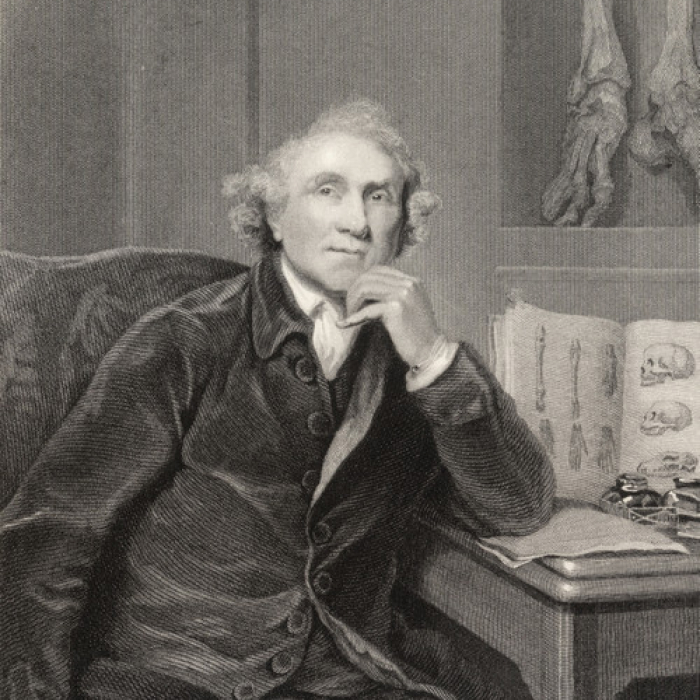John Hunter
A man of whom little is known, John Hunter was a British army physician sometimes called the “father of scientific surgery,” who attempted in this text to summarize “almost everything which all the curious investigators of the planet have seen and told” (366). He published his work in Edinburgh in 1775 shortly before Blumenbach published his more celebrated On the Natural Variety of Mankind. Hunter’s work—called an “Inaugural Disputation” in the Table of Contents but “Inaugural Dissertation” in the text—was, in the moment, eclipsed, but it was reprinted in the 1865 English translation of Blumenbach’s anthropological treatises (see Blumenbach entry). Hunter’s dissertation is notable for the stringent naturalism of its exposition, its insistence on fertility as a criterion of species membership, and its conclusion that humanity constitutes a single species, in all respects confirming the conclusions of Buffon. Because Hunter’s expository style is often diffuse and somewhat ponderous, a précis will take the place of a selection.
Hunter treats all explanations of human difference that refer to the will of God as revealed in the Bible as mere superstition and an impediment to science. He notes the distinctions often adduced as evidence of species differences but argues that thick lips, depressed noses, small or large eyes, and so forth can be found within any group; indeed, he says, if mere difference is the criterion, then there are no group distinctions at all: “Could it not be said of the same man at different times that he in like way was of a different species from himself?” (361). For Hunter, the term species must be defined as “A class of animals, of which the members procreate with each other, and the offspring of which also procreate other animals, which are either like their class, or afterwards become so” (363). Since all humans can meet this test, “my opinion is that men must be held to be of the same species” (365).
Hunter organizes his discourse with sections on color, stature and form, “excess or defect of parts,” and mental faculties. With respect to color, he provides a “Table of Colours,” including Black, Sub-black, Copper-colored, Red, Brown, Light brown, and White, each one paired with the geographical areas in which that color is primarily found. Thus:
Black: Africans “under the direct rays of the Sun,” along with inhabitants of New Guinea and New Batavia;
Sub-black: “The Moors of Northern Africa” and Hottentots;
Copper-coloured: East-Indians;
Red: American Indians;
Brown: Tartars, Persians, Arabs, northern Africans, and Chinese;
Light brown: Southern Europeans, Sicilians, Abyssinians, Spanish, Turks, Samoeides and Laplanders;
White: “Almost all the remaining Europeans” (366-67).
As to the cause of these colors, Hunter discounts theological sources of information (e. g., the curse of Ham) and focuses on the influence of climate, especially the heat of the sun, which produces a thicker “cuticle” in blacks. The fact that Negroes are born white and remain so for several hours suggests to some that white was the original color of mankind. But Hunter draws no inference from this curious fact, arguing that the cause of skin color remains undetermined but suggesting that it must include not only environment but also diet, exercise, and “mode of life.” The influence of sustained exposure to sunlight on the human body seems, however, to be particularly strong, given that “the inhabitants of warm regions very soon reach their full size . . . . In the eighth, ninth, or tenth year, women become menstruous, in the twelfth the men are fit for venery; whereas in cold regions, the menses do not appear before the fourteenth, sixteenth, and sometimes the twentieth year” (379). Hunter concludes with a rhetorical question about the cause of differences in general: “What is the cause of difference? Is it to be referred to God? and is it credible that a Deity who is just and equitable to all should have formed men so different in mind, as to create one foolish, another wise, one brave, another cowardly? Certainly not, in my opinion” (389-90).
Hunter had a substantial collection of animal and human skulls, which he arranged around the borders of a pool outside his private museum according to their “facial angles.” A young surgeon, Charles White, was enormously impressed by what seemed to be a downward progression in Hunter’s collection: European, Asiatic, American Indian, Negro, orangutang, monkey. Hunter’s collections of materials currently reside in the Hunterian Museum at the Royal College of Surgeons in London.
